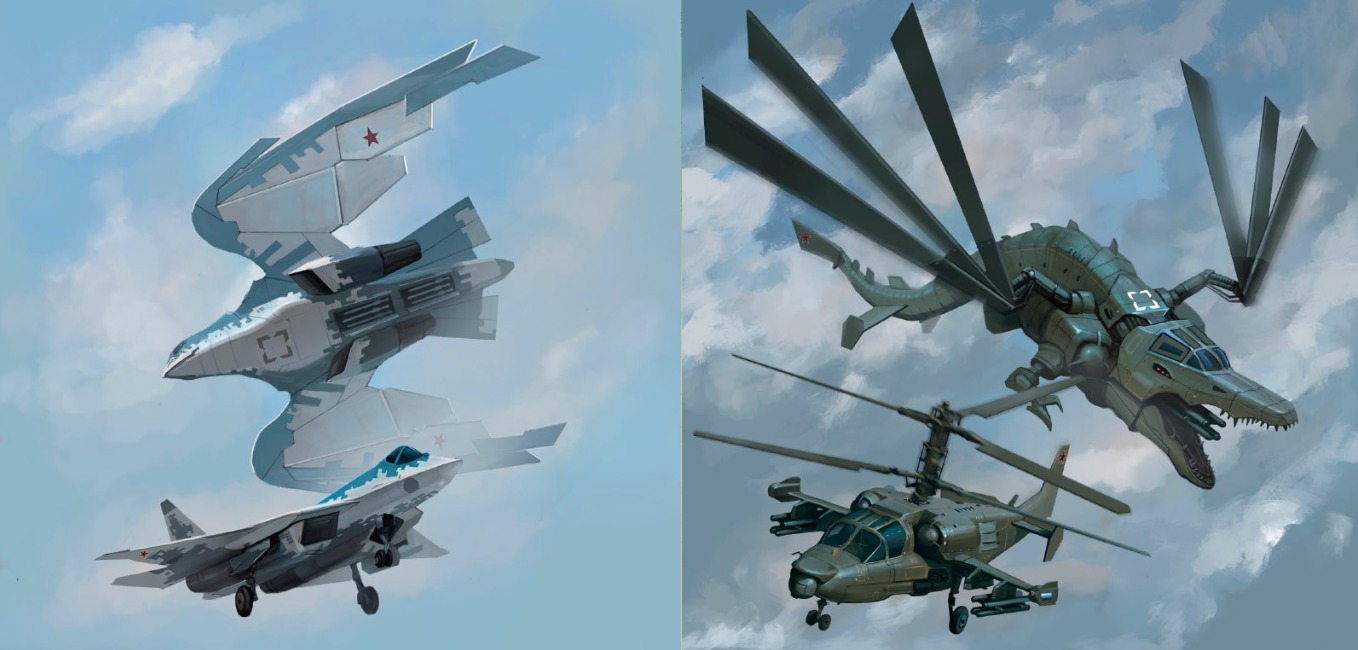Russia’s Rostec presented striking examples of Russian weapons depicted as fantastic mechanized monsters – the fifth-generation Su-57 fighter, the T-90M tank, the Lancet UAV, the Pantsir anti-aircraft missile, Ka-52 attack chopper and heavy flamethrower system TOS-1A “Solntsepek.”
The new looks of the Russian weapons were published on the Corporation’s Telegram channel.
“In this project, we represent the military equipment of the state corporation participating in the NMD as mechanized monsters. 90% of the military equipment used in the special operation zone was produced at Rostec Enterprises. All these weapons have their unique but invariably formidable character,” Rostec said.
The T-90M “Proryv” tank was depicted as a bear. Lancet UAV was depicted as a bee. The Su-57 fighter is shown as a falcon robot. The aircraft can “gain dominance ” and hit ground targets with precision. The nature of this machine reflects the appearance of a bird of prey.
Earlier, Russia announced its plans to “significantly” ramp up the production of the Su-57 fifth-generation fighter, aiming to bolster its fleet of cutting-edge stealth aircraft.

In the lead-up to the Army-2023 international military-technical forum, Vladimir Artyakov, the first deputy general director of Rostec, said there are plans to significantly enhance the production pace of the Su-57 fifth-generation fighters, with a strong focus on substantial progress in 2023.
Artyakov thoroughly adhered to the commitments outlined by the Ministry of Defense, ensuring complete compliance. The aircraft is actively engaged in a trial operational phase within the Russian Aerospace Forces (VKS) framework.
In the ongoing cooperation spearheaded by Obyedinyonnaya Aviastroitelnaya Korporatsiya (OAK), a Russian aerospace and defense corporation, this year holds the promise of a substantial acceleration in the production tempo of these aircraft, Artyakov said.
Furthermore, Artyakov elaborated on the dynamic progression of the Su-57 platform. He noted an augmentation in its combat capabilities, accompanied by the seamless integration of cutting-edge technologies into the system.
In August 2018, the Russian Defense Ministry first contracted Sukhoi Company, a UAC subsidiary, for two Su-57 jets by 2020. Another deal was struck at Army 2019 exhibition to provide 76 Su-57s, including the first two, to the Russian Air Force.
Serial deliveries of the Su-57 commenced in 2022, with the Russian defense ministry set to receive 22 fighters by the close of 2024. This number is projected to rise to 76 by 2028.
To ensure timely deliveries, Russia undertook several measures last year, including expanding its industrial capacity to increase the production pace of its fifth-generation Su-57 fighter aircraft.
The aim of modernizing and expanding these facilities is to expedite the production process of the Su-57 Felon fighters.
These fighter jets have regrettably been subjected to delayed deliveries, a predicament that has not escaped the attention of critics on multiple occasions.
Rostec To Supply The Su-57 With New Engines
While striving to expedite deliveries, the Russian defense sector also unveiled plans to initiate the serial manufacturing of fifth-generation Su-57 fighters featuring new engines.
Artyakov, in an interview with RIA Novosti, disclosed that the commencement of deliveries for Su-57 fighters incorporating second-stage engines is slated to take place within the framework of the existing agreement with the Ministry of Defense of the Russian Federation.
Artyakov further noted that aircraft featuring second-stage engines are currently undergoing rigorous flight testing. Moreover, as part of the ongoing serial contract, there is a strategic blueprint to equip the Su-57 with a new engine.
United Engine Corporation and OAK are collaboratively carrying out this undertaking.
He elaborated that the Su-57 has been meticulously designed to accommodate the utilization of engines from both the first and second stages.
Notably, he underscored that even with the deployment of a first-stage engine, the fighter fulfills the fundamental requisites indicative of a fifth-generation aircraft.
However, Artyakov refrained from providing a specific timeline for delivering the Su-57 with the new engines to the Russian Air Force.
In October 2022, the EurAsian Times reported a significant development, detailing that an adapted version of the Su-57 stealth fighter, equipped with second-stage engines, successfully embarked on a test flight, marking a pivotal milestone in its evolution.
In December 2019, Yuri Slyusar, the United Aircraft Corporation (UAC) general director, was quoted in Izvestia affirming the intense testing regimen underway for the Stage 2 engine.
These tests encompassed thrust vectoring trials during flight, alongside comprehensive assessments of the engine’s oil system within challenging flight conditions. Furthermore, the process of bench-testing the engine was also actively underway.
A representative from the Sukhoi Design Bureau conveyed to TASS in September 2022 that the Su-57 sets itself apart from fourth-generation fighters by retaining supersonic speeds for most of its mission profile, even during combat engagements.
The representative noted that while fourth-generation aircraft predominantly operate at subsonic speeds and occasionally transition to supersonic flight for specific combat tasks, the Su-57 is uniquely designed to operate predominantly at supersonic speeds throughout its operational lifespan.
The latest revelations come as Russia readies itself for the forthcoming “Army” forum, scheduled to take place at the “Patriot” park in the suburban area of Kubinka from August 14 to 20, operating under the patronage of the Ministry of Defense of the Russian Federation.
- Contact the author at ashishmichel(at)gmail.com
- Follow EurAsian Times on Google News